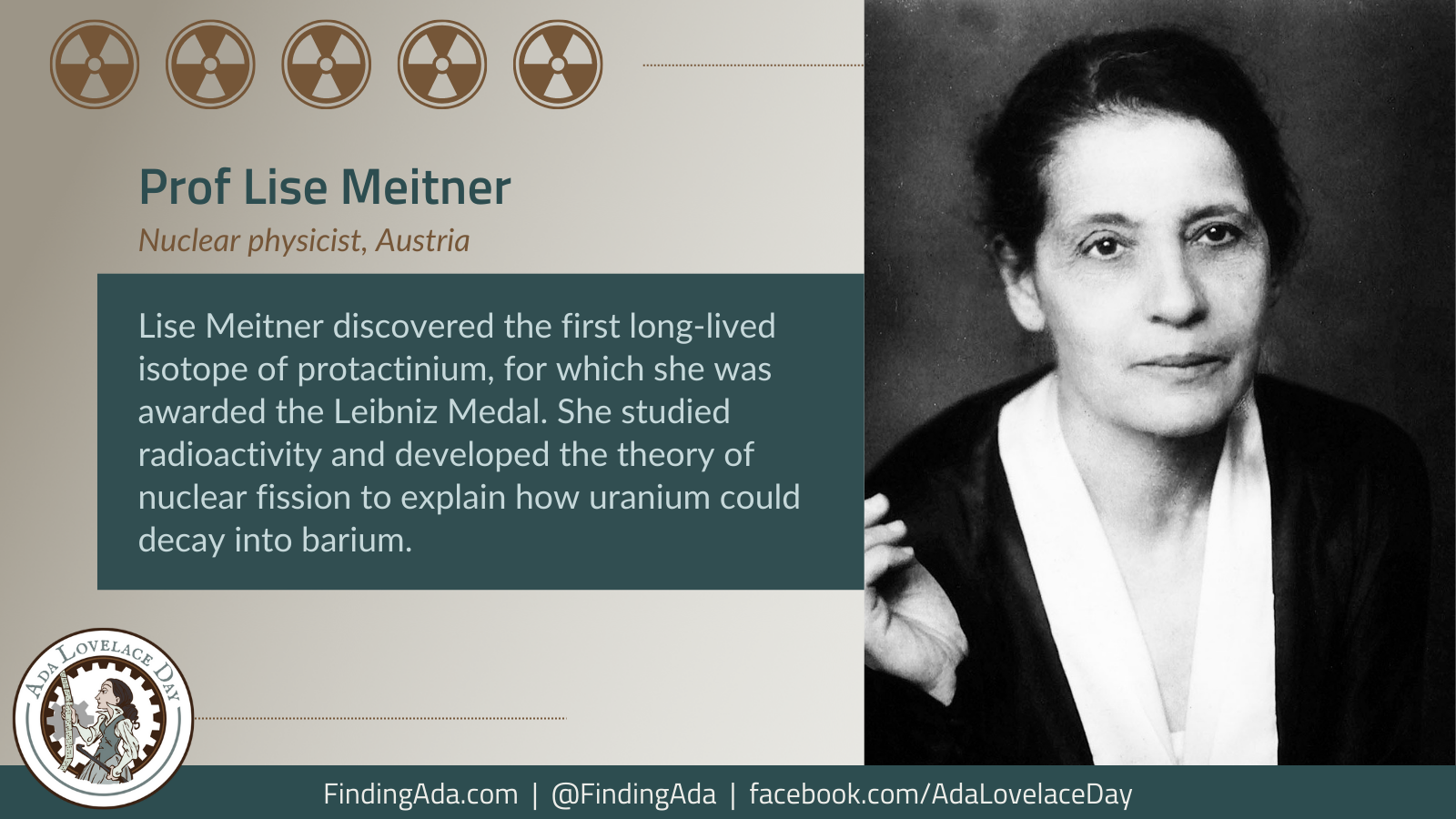
Professor Lise Meitner
Professor Elise ‘Lise’ Meitner was a physicist who discovered the element protactinium and developed a theory of nuclear fission.
Lise Meitner was born in 1878. Fascinated by science and mathematics from an early age, her educational opportunities were severely limited because of her sex, and she had to take private lessons so that she could sit her exams. In 1905, she became only the second woman to earn a doctorate in physics from the University of Vienna.
After initially studying optics, she moved on to radioactivity which was, at that point, a new field of study. She discovered that when a beam of alpha particles was fired at metal foil, its scattering would increase with the increased atomic mass of the metal atoms. Ernest Rutherford used the results of this experiment to then predict the nuclear atom.
Meitner was unusual in being allowed to attend Max Planck’s lectures, as Planck generally rejected the idea that women should be allowed to get an education but he recognised her as an exception. At this time, she was introduced to Otto Hahn, a chemist, with whom she began a lifelong collaboration. They developed a new way to detect isotopes and tests soon resulted in the discovery of two new isotopes. Meitner then began studying beta radiation.
Hahn and Meitner moved to the Kaiser Wilhelm Institute (KWI) for Chemistry, in 1912, where he became a professor whilst her position was as an unpaid ‘guest’. But later that year Plank employed her as an assistant, making her the first female scientific assistant in Prussia. She soon got promotion to associate, though, and later an increased salary to persuade her not to move to Prague.
With the outbreak of World War I, Meitner trained and then worked as an x-ray nurse-technician. She was discharged in 1916.
The next year, she was given her own lab at KWI, where she started to search for the ‘mother isotope’ of actinium. As the men at the institute had been called up, she did much of the work herself and discovered the first long-lived isotope of protactinium, for which she was awarded the Leibniz Medal.
At the beginning of World War II, when Austria was annexed by Germany, Meitner fled to Sweden. She and Hahn met in Copenhagen to discuss experiments that Hahn had conducted in his lab in Berlin. One key experiment showed that when uranium was bombarded with neutrons, it split into two, and one of the resulting elements, thought to be radium, behaved like barium.
Meitner and her nephew Otto Frisch, who was also a physicist, discussed the data and Meitner theorised that the uranium broke into barium (and krypton). If the element was barium, then this would be evidence of fission, but if it were radium, it could not be fission because radium was too big. But there was no theory for how uranium could decay into barium. The two of them worked out how this decay could occur, developing the theory of nuclear fission.
Meitner and Frisch came up with an experiment which would test this theory and asked Hahn to examine the byproducts of uranium bombardment in more detail. Hahn confirmed that it was indeed barium, not radium, proving Meitner’s theory of nuclear fission. It was clear that fission could produce large amounts of energy, and whilst this resulted in the Manhattan Project in the US, Meitner refused to have anything to do with research that might lead to the development of a bomb.
In 1944, Hahn received the Nobel Prize for Chemistry for his fission research, but Meitner’s work was ignored. She did, however, receive the Enrico Fermi Award in 1966 along with Hahn and his colleague Fritz Strassmann.
In 1992, element 109, which is currently the heaviest element in the known universe, was named Meitnerium (Mt) in her honour, one of just two elements named after women (the other, curium, was named after Marie Curie).
Further Reading
- Lise Meitner, Wikipedia
- Lise Meitner (1878 – 1968), Atomic Archive
- Lise Meitner, Atomic Heritage Foundation
- Meitner & Frisch On Nuclear Fission, Atomic Heritage Foundation
- Lise Meitner, New Scientist
- Otto Hahn, Lise Meitner, and Fritz Strassmann, Science History Institute
- Lise Meitner: A Physicist & Chemist Whose Legacy Lives On, Chemistry Talk
- This Month in Physics History – December 1938: Discovery of Nuclear Fission, American Physical Society, December 2007
- Science Stories: Lise Meitner, Philip Ball, BBC News World Service, 8 January 2018
- Lise Meitner – the forgotten woman of nuclear physics who deserved a Nobel Prize, Timothy J. Jorgensen, The Conversation, 7 February 2019
- Lise Meitner: the nuclear pioneer who escaped the Nazis, Philip Ball, BBC Science Focus, 3 December 2019
- Overlooked for the Nobel: Lise Meitner, Margaret Harris, Physics World, 5 October 2020
- Lise Meitner: A Noble Scientist, Olivia Fraser Barsby, McGill: Office for Science and Society, 4 March 2021